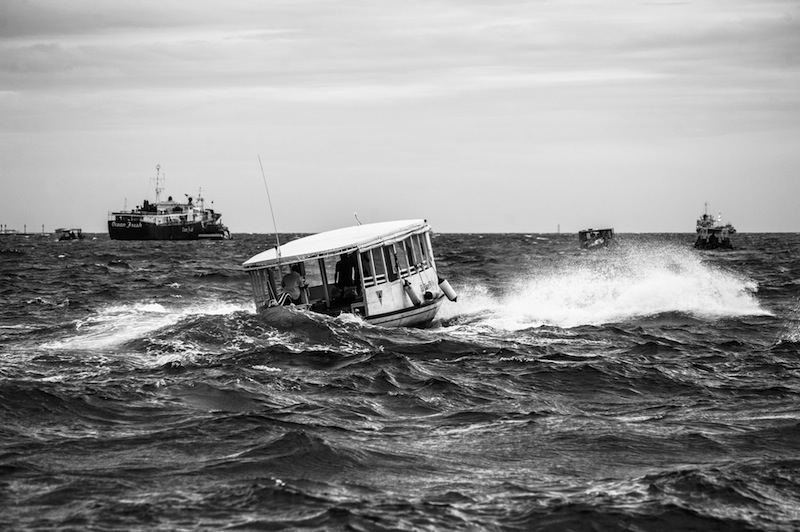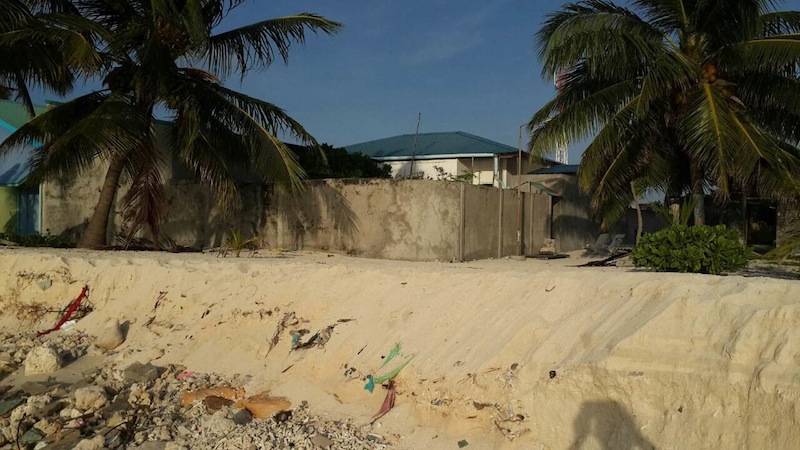– HA. Dhidhoo, December 2013 – The sand bags piled on HA.Dhidhoo island’s beach to restrict erosion are visible from
Zubaidha Abdul Razzak’s front door. The mother of four said the ocean used to be
250 feet away from the house, but now, during stormy weather, waves lap at her front
door.
“The water in my well is salty. It corrodes the taps, and my children have had hair fall
and skin problems because we shower with groundwater,” she said.
The main sources of water on Dhidhoo – an island of approximately 5000 people and
a land area of 85 hectares – are groundwater, rainwater, and in recent years, bottled
water. The groundwater in the island has become salty and contaminated due to
erosion, overuse, and sewage water being pumped into the ground. In May during the
dry season, the island now runs out of potable water. A population boom,
mismanagement of water resources and unpredictable rainfall usually has led to this
shortage. According to Dhidhoo Island Council, the government provides up to 90
tonnes of desalinated water (produced in neighboring Kulhudhuffushi Island) to plug
the annual shortage in Dhihdhoo.
 PHOTO: Ali Nishan
PHOTO: Ali Nishan
“The ocean used to be 250
feet away from the house,
but now in stormy weather,
waves lap at my front door”
Resident of HA. Dhidhoo,
Zubaidha Abdul Razzak
In 2011, the Government of the United States announced and
signed a memorandum of understanding with the Government of
Maldives for a total of US$ 7.3 million project to provide an
island-wide solid waste management and an island-wide
desalinated water supply system, piped and metered to individual
households in Dhidhoo and LH.Hinnavaru. On 27 September
2011, USAID directly subcontracted the water project to an
American company Chemonics International. For this project the
selection of the project was carried out by the donor directly.
However, with the exception of repeated announcements by the
two most recent US Ambassadors to Maldives, there were no
further news of the solid waste management system.
Furthermore, to date the promised water supply system has not
materialized.
Community Commitment
Public expectations regarding the water project are high on
Dhidhoo. On July 10, 2012, the US Ambassador Patricia Butenis
visited Dhidhoo and pledged to provide a safe water system and
improve the existing sewerage system on the island.
USAID had chosen Dhidhoo and Hinnavaru Islands as the same
agency had installed a sewerage system in Dhidhoo and assisted
in the installation of a 30 tonne desalination plant in Hinnavaru
in 2010.
According to Ministry of Environment and Energy (MEE),
Chemonics International carried out several studies during 2012
– the first year of the project.
One such study, titled “A financial analysis of waterand sewer
infrastructure alternatives”, completed in May 2012, detailed out
the financial capacity to operate the planned water supply
system. The study concluded that there were insufficient funds
for a piped water network and recommended alternative methods
such as having a truck transport water to households. Chemonics
International proposed to install a central water supply using rainwater storage in community water tanks by means of
community tap bay.
However, MEE rejected the proposal, reminding USAID that the
original project proposal approved by government was to install
a piped and metered water supply to every household in both
Hinnavaru and Dhidhoo. The ministry said these plans had
already been communicated to the island councils as well as the
beneficiary communities and said the project must be
implemented according to the approved scope.
In December 2012, USAID informed the Government only US$
1 million remained for infrastructure development.
After several discussions and negotiations, in May 2013, USAID
agreed to allocate an additional US$ 3 million for infrastructure
development; a figure only sufficient for a piped network in
Hinnavaru, only one of the two islands. The government was left
with the task of explaining to the community of Dhidhoo that the
project will not proceed due to insufficient funds while at the
same time it is unclear why this happened.
Lack of information
Dhidhoo, as the capital of Haa Alif atoll and comprising a large
population, is a priority island for the government. However, the
government had not included provisions for a water system for
Dhidhoo in the state budget due to the USAID project.
Dhidhoo Island council member Abdulla Siraj criticized USAID
saying: “For a long time we were unaware of what was going on.
They come to this island every two months, but we don’t see
what they do. Are they trying to show us a dream?” he said.
Expectations are high on the island, Siraj said adding, “Everyone
knows the money has been allocated. The US Ambassador came
here. There is a project office, but we do not know what is
happening. Of the total amount for the two islands, we do not
know how much was allocated for Dhidhoo”

PHOTO: Transparency Maldives
Zubaidha Abdul Razzak’s home – the ocean used to be 250 feet away but now, during stormy weather waves lap at her front door.
Raising awareness for phantom projects
Donors must not allocate funds for soft components if there is no
money for infrastructure, the MEE has said.
“During this project, a lot of money has been spent on studying
various options with various consultants. Similar studies have
been done in other islands. I do not believe such studies need to
be done every single time,” a Director General at MEE said.
While the studies were ongoing, Chemonics International has
subcontracted local NGO Live and Learn to conduct awareness
projects on the island. A Live and Learn Staff Usman Ashraf said
he has conducted three awareness projects this year on water
management and safe use of drinking water. These activities are
now being questioned as the final project is not being delivered
and furthermore seen as wasteful as the issue of lack of funds for
infrastructure component is raised by the donor. “They have
wasted the allocated money on staff salaries, awareness programs
and useless studies,” Siraj said.
Donors must understand the scope of the projects they commit to,
MEE said. “When we say we want a piped network, they have to
understand what it means. We have emails and communications
that very clearly states that the government wants a piped
network in Dhidhoo and a piped network is expensive,” they
said.
According to MEE, the project had also been impacted due to the
USAID focal point changing over time and different individuals
visiting the Maldives for follow-up visits.
Who should raise the alarm bell?
Had Chemonics International been reporting to the MEE, the
ministry could have intervened to stop use of funds on repetitive
studies. The contractors did not report to directly to MEE on a
regular basis because the project was implemented outside the
normal Government procedures. Projects are audited by the
Auditor General’s Office only by specific request of the donor.
Alternatively such projects would be audited by a private audit
firm, which may not capture the progress of projects against the
intended work-plan nor analyse the benefit to communities and
adherence to government policies. Such aspects are addressed
by Auditor General’s Office and government encourages more
involvement of AGO in donor funded projects as well. Such
projects also need to be reported on a regular basis to the central
monitoring agency of the government, Office of Programmes
and Projects who conducts onsite monitoring of projects they
oversee. No government agency also visited the island to assess
progress for this project. In addition, keeping the local councils
more informed is also a crucial monitoring strategy. For this
project, Dhidhoo council noted that they never received a
workplan or a copy of the contract made with Chemonics and
thus they were unable to monitor or report any delays.
Dhidhoo’s water project demonstrates the importance of donors
collaborating with the government in project implementation,
monitoring and oversight. Dhidhoo further shows project
designs need to align with community needs, and must be
implemented with the participation of government and local
councils.
Sustainable Solution
Meanwhile, Zubaidha continues to hope for a water system. She
is waiting for a gutter system to be installed in her house so she
can collect rainwater for drinking and cooking.
“But a tank is not a sustainable solution. We want safe water in
our plumbing system too,” she said. “I’m hoping we get potable
water as soon as possible. We are constantly told we will get it
soon, people are constantly coming to survey, but we have not
seen a solution yet.”
Aishath Reetho, Senior Planner at Ministry of Housing and
Infrastructure said the government is now negotiating with a
private party to develop the water and sewerage system in
Dhidhoo under a public-private-partnership model. The private
party is to be offered concessions to build luxury villas in an
uninhabited island in Baa Atoll in return for 400 housing units
and a water and sewerage system in Dhidhoo. If the project is
approved, it will take another two years to complete the water
system. While the community waits for this untested model to
be successful, will they ever know why funds dried up for the
promised project?